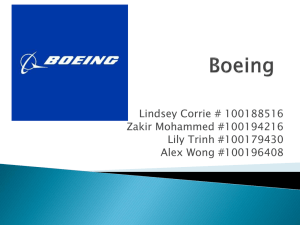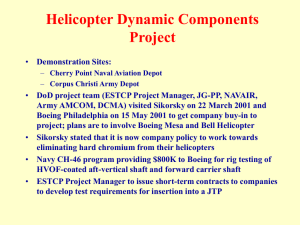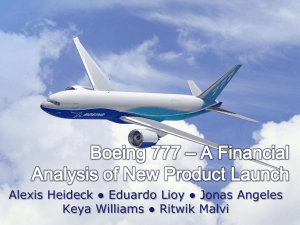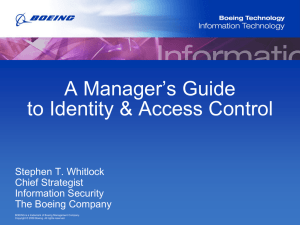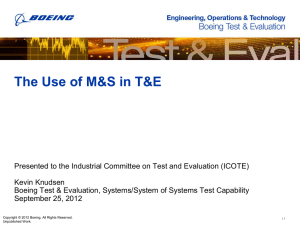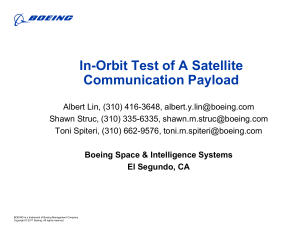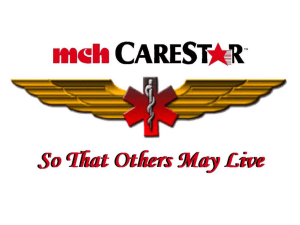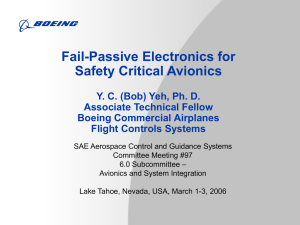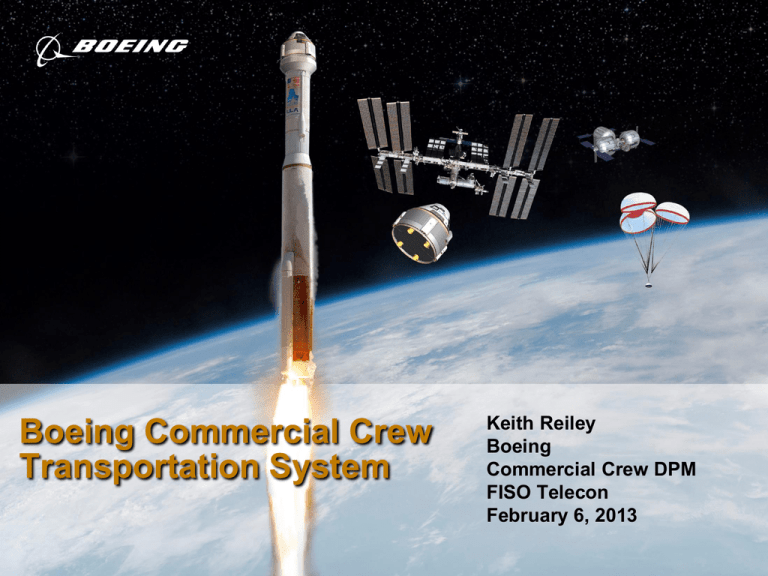
Boeing Commercial Crew
Transportation System
Keith Reiley
Boeing
Commercial Crew DPM
FISO Telecon
February 6, 2013
Content
• CSTS Overview
• Operations Concept
• Vehicle Features
• CCDev2 and CCiCap
Progress
• Development Schedule
Copyright © 2012 Boeing. All rights reserved.
Boeing Brings History of Human Space
Flight & Commercial Airplanes Together
Copyright © 2011 Boeing. All rights reserved.
Copyright © 2012 Boeing. All rights reserved.
Commercial Crew
Transportation System (CCTS)
• Complete transportation
system
– Commercial Crew Vehicle
– Launch Vehicle
– Ground Operations
– Mission Operations
– Recovery
• Design objectives dictate
uncomplicated systems and
proven components
– Safe and reliable
– Low development risk
– Low recurring cost
• Compatible with a variety of
launch vehicles
– Have down selected to Atlas V
for initial flight tests and
verification
Boeing CST-100
Partners & Subs
Bigelow Aerospace
PWR
General Dynamics
Airborne Systems
Spincraft
• Operational in 2016
Copyright © 2012 Boeing. All rights reserved.
4
Concept of Operations
Copyright © 2012 Boeing. All rights reserved.
5
Spacecraft Segment (CST-100)
Ascent Cover
Forward Window
Side Hatch
Crew
Module
Umbilical
CM SM
Service
Module
Radiators
Copyright © 2012 Boeing. All rights reserved.
Thruster
Doghouse
6
Launch Abort System
• Provides abort capability from the launch pad
through Earth-orbit insertion, protecting against:
– Complete or partial loss of ascent
Bantam Engine
thrust/propulsion
– Loss of attitude or flight path control
–Time-critical system failures
Launch Abort Engine Test Firing
No “Black Zones”
OMAC RCS Engine Test Firing
Copyright © 2012 Boeing. All rights reserved.
7
CST-100 Key Design Features
Crew of Seven or
Combination of Crew and Cargo
Reusable Crew Module (CM)
Expendable Service Module (SM)
Liquid Propellant
Launch Abort System
Land Landing on Airbags
Copyright © 2012 Boeing. All rights reserved.
8
CM Internal Layout
Landing
Attenuation
Seat Struts
Avionics and Software
Integration lab
ECLSS
Crew/Cargo
Accommodations
Control Panel
Layouts
Copyright © 2012 Boeing. All rights reserved.
9
CST-100 Design Evolution
IDR-1
IDR-2
IDR-3
ISR
SDR
PDR
IDR-4
Copyright © 2012 Boeing. All rights reserved.
10
Landing Opportunities
Nominal returns
to WSMR
Edwards AFB
available for additional
landing opportunities
Emergency
water landing
opportunities
Copyright © 2012 Boeing. All rights reserved.
11
CST-100 CCDev Design
Landing Drop Tests
Copyright © 2012 Boeing. All rights reserved.
12
CM/SM Assembly in KSC OPF-3
Fueling Operations Before Flight
Base Heat Shield Installation
Copyright © 2012 Boeing. All rights reserved.
13
CCiCap Base Period
Major Milestones 2013-2014
Copyright © 2012 Boeing. All rights reserved.
14
CCTS Design Maturation Under
CCiCap Aug. 2012 through Jan. 2013
Integrated System Review
– Established and demonstrated CCTS Vehicle and operations that meets
system requirements
Production Design Review
– Established the baseline plan, equipment and infrastructure for performing
the manufacture, assembly and acceptance testing of the CST-100
– Leveraged successful and extensive Boeing Commercial production
practices
Phase 1 Safety Review Board
– Conducted a comprehensive safety review to access conformance with
NASA’s Crew Transportation System certification process
– Focused on hazard reports, cause descriptions and controls
CST-100 Interior Layout Evaluation
– Completed three-day evaluation with NASA astronauts on reach and
visibility of controls/displays
– Received feedback on the design of the crew seats, interior lighting, and
optimum layout for Crew Resource Management
Software Engineering Release 2.0
– Initial release of flight software
Landing & Recovery/Ground Comm. Design Review
– Preliminary design of ground and communications architecture
Copyright © 2012 Boeing. All rights reserved.
15
CCTS Design Maturation
Under CCiCap 2013 Milestones
Boeing’s CCTS 2013 Plan:
– Continue system design maturation – multiple
demonstrations
– CST-100, Atlas V integration and Launch Pad Modifications
– Mission Control demonstrations
– Continued re-development of the ULA Dual Engine Centaur
– Launch Vehicle Adapter PDR & CDR
– Continued development of KSC OPF-3
Copyright © 2012 Boeing. All rights reserved.
16
CCiCap Risk Reduction
Demonstrations
•
•
•
•
Phase II Wind Tunnel Tests
OMAC Engine Development Test
LV EDS Test
DEC Liquid Oxygen Duct Development
Test
• Avionics and Software Multi-string
Demonstration Test
• Pilot-in-the-Loop Demonstrations
Copyright © 2012 Boeing. All rights reserved.
17
Full Crew Transportation
Capability by 2016
• CST-100 takes
advantage of heritage
hardware to reduce
schedule risk
– Orbital Express
demonstrated AR&D
– Apollo heritage
parachute system
– Abort system using
existing components
– Avcoat from Apollo
– Delta-based spin formed
structures
– Airbag landing system
from Boeing CEV/Orion
2010
SDR
2011
2012
PDR
CCDev
CCDev-2
2014
2015
2016
CDR
Structural Test Article
Pad Abort Test
CCiCap
Orbital Flight Test
(uncrewed)
Two-Crew Flight Test
Air Bag System
Integrated AR&D System
Copyright © 2012 Boeing. All rights reserved.
2013
Apollo/Orion
Heritage
Avcoat
SM Abort Engine
Heritage
Parachute
System
Weldless
Structure
Simple, Passive
Life Support
Systems
18
Boeing Commercial Crew
Summary
• Significant Progress to date under
CCDev, CCDev-2, and CCiCap
– All milestones completed to plan
– Critical Design Review in Apr, 2014
• Low Risk, Low Cost Development
– Simple systems
– Existing technologies
– Proven launch vehicles
– NASA’s acquisition approach caps
costs through firm milestone values
– Demonstrated commercial
development approach with NASA
involvement
• Low Operational Costs
– Leveraging Boeing’s commercial
aircraft experience
– Multiple mission capsule
Reliable, Safe Transportation Soon
Affordable Access to LEO Enables Exploration Beyond LEO
Copyright © 2012 Boeing. All rights reserved.
19




